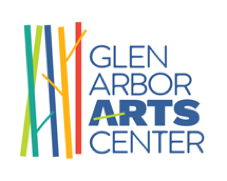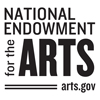
Creativity Q+A with Carrie Betlyn-Eder

Artist Carrie Betlyn-Eder, 68, first visited Leelanau County in 1968, as a child with her siblings and parents. She watched the moon walk from a house in Leland, and got a taste for the place [“It just got under my skin”]. In 2022, Carrie and her husband, Mickey, relocated from St. Paul, Minnesota. Carrie, a native Chicagoian, traded sunrises for sunsets, an urban life for a rural life, and found an abundance of new materials — and ideas — in the woods with which to create her mixed media construction.
This interview was conducted in September 2023 by Sarah Bearup-Neal, GAAC Gallery Manager, and edited for clarity.
Pictured: Carrie Betlyn-Eder
Describe the medium in which you work.
Stuff. I work in things that I see, that grab my fancy: assemblage, papier-mache; pretty much all found, salvaged things I find around. Occasionally I’ll buy something [materials].
You wrote this on your website: My work grows out of an inherent instinct to scavenge, and my fascination with connections, literal and imagined. What does that mean?
That means I like to pick things up when I’m walking — I walk all the time. I used to live in Chicago, where there’s lots of stuff to pick up. As I moved, first to St. Paul, Minnesota, then here [Leelanau County], there was less detritus and more organic materials to work with. It’s how I see things. I’ll look at an object and say, That looks like a breast, or a bird. I’ll put it with the rest of the collection, and I’ll remember it’s there. The next time I’m looking for something like that, I’ll go, Remember that thing you found on 57th Street? That’s there. Let’s go find it. So, when I put the pieces together, there is the thing — an implement, or a piece of rusty metal, or more nowadays, plastic. [Carrie adds that the found object functions on several layers: What it was, what it’s becoming, and what it might say when it goes out into the world and seen by somebody.] How these objects relate to each other appeals to me. Sometimes, when I’m really on my game, it says something about the world, and about me, and my relationship with those things.
Contrast and compare what you might find when you’re on the streets of Chicago versus on the streets of Leelanau County.
Here, my work has been drawn to nature as a result of having more natural objects from which to choose — I have four acres, and there’s all sorts of fascinating, gnarled bits and pieces of flora, predominantly, that are becoming birds. They’re, literally, heads. In the past, particularly where I walked on the [Lake Michigan] lakefront on the south side of Chicago where I lived, things were falling apart: limestone, rebar, live things trying to grow up in between all these dilapidated efforts to try to control the lakefront. I did a lot with rebar for a while — rusted, metal shapes where the storms had changed how they held the limestone or cement in place. I did a piece once that looked like a DNA model because of the way the rebar had been curved. It was this wonderful treble clef with lines running through it.
Did you receive any formal training in visual art?
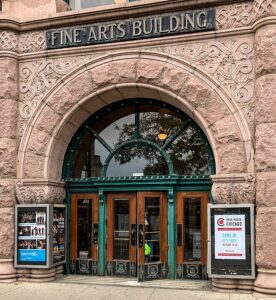
Not in visual art. I’m trained as an actor and a dancer. I started [professional] life as a dancer. I left high school, joined a regional ballet company in upstate New York. [After suffering injuries, Carrie moved onto acting.] I’m trained up the wazoo as an actor: I have a BA in Theater from the University of Michigan, and an MFA from the Goodman School of Drama in Chicago. I worked in theater until I had my son [1991]. All during that time I did a lot of collage — as a sort-of therapy. I grew up in the world of art. My grandparents [owned the Guildhall Galleries] in Chicago from the 1950s to the 1980s. A Michigan Avenue gallery. All mid-century European artists. Some Chicago artists. And, I kind of lived there. One of [the gallery’s locations] was in the Fine Arts Building for many years, and I studied dance upstairs, and then I’d come down to the gallery when I was done, and hang out there. It was a really rarified, amazing way to be exposed to art. My mother was a painter. She started doing assemblage work when I was a kid — there was a fire across the street from us, and we’d go salvage remnants from it, bring all these cool things home and she’d make stuff. I wasn’t actually doing assemblage at the time, but it obviously seeped in. I think what my mom taught me was how to look at stuff, and how to see things differently, or with possibilities.
Dance and theater are both creative activities. I don’t see big difference between the practice of those and visual art — it’s all about creative problem solving.
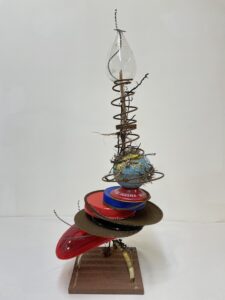
I agree with you entirely. What I discovered in my old age is the thing that has been constant through all these efforts — and I started dancing when I was 4 — is it has always been about composition, and telling a story. [In theater, dance, and visual art making] it was all about taking disparate parts, whether they’re internal or external, and making a whole that was pleasing to me, and could possibly translate what I was trying to say. When I started making visual art seriously, it was so much easier because I didn’t have to worry about 15 other people. It was just me, in a space with my stuff, doing what I wanted to do. There was so much pleasure in it. Certainly, in terms of acting which is what I spent the most time doing seriously, I liked rehearsing. I like doing research, I like thinking about things, and spending days just trying stuff. This allows me to do that in a really safe, comfortable place. And then the scary part is having to put it out [exhibiting].
What you’re talking about is process. On your website, again, you said, I’m fascinated by process. Any process. Why is process such an important thing in your practice?
The biggest thing is the high. When I’m really working, and trying, I get such a great feeling from that — more than from any finished product. The work: It’s an amazing feeling. I’m looking for how things fit together, intellectually and emotionally; how they fit together in terms of beauty and structure. All of those things need to tick off in the process of making whatever it is I’m making. If something is quite right, I definitely get stuck. I need to walk away from it a bit. I need to do something else. That’s why I walk a lot, to think about things. I’ve learned you can’t muscle stuff into place. All of these issues I feel are consistent with day-to-day living.
Describe your studio space.
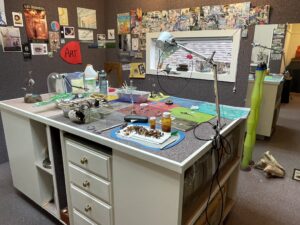
Moving to Leelanau has given me my first, real studio space that hasn’t been the dining room, kitchen, basement, boxes of stuff everywhere. One of my tenets is that you work with what’s at hand. [Carrie’s studio is a finished outbuilding on her property.] If you need something that isn’t there, then maybe you don’t need it. I’m living the dream now. I can just walk into my space, and I have space [that is organized] and I also have it set up like a little gallery with different bodies of work. I came here so that this last part of my life would be how I wanted it to be — with peace, and creativity. I had high hopes for the potential of finding creative community here. This is heaven. It’s perfect. If I’d dreamed of a place, it would not be much different than this. When we lived in St. Paul, I had part of the kitchen, so I could glue some stuff together then go cook. I learned to make things work for me. And my family was very patient with having my stuff all over the apartment.
What’s your favorite tool?
It’s either my hands or my eyes.
Why is making by hand important to you?
It’s important to me because it’s essential to living. We all have hands. There’s the potential for all of us to use these things [hands] to do something. What I love about art and life — and those things are pretty much the same — is that we can all partake of that. It doesn’t have to be capital “A” Art. But you can make something with almost nothing because you have hands.
When did you commit to working on your visual art with serious professional intent?
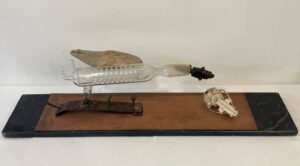
Shortly after Sam was born. I’d been given a gift of laboratory glass by my father. I was really taken by these shapes — Frankenstein’s lab kind of stuff, curly cues. The shapes of these things were really evocative to me. I decided it would be fun to stick them together, and making these found object vessels. I would say this was the early 1990s. I made a bunch of these. I stuck them in my car and started driving around to galleries, and a couple galleries said, Oh, these are cool, let’s see if we can sell them. I wanted them to be useable. I bought doll-house sized [water] pitchers so you could fill [the vessels, which held one or two flowers]. It was very minimal. I was influenced by Ikebana. My great aunt was a practitioner. The best class I took in college was on Japanese painting, so that whole aesthetic — the simplicity of line, ornament just really appealed to me. After a few years I was wanting to tell more stories, and I was running out of lab glass, so I started making more narrative pieces.
What role does social media play in your practice?
Other than using it to look at what other people are making, and getting an idea of what’s happening in the real world of art, I would say I don’t use it very much. I have a Facebook page that, for years, I would use to announce shows at the gallery I was at in Chicago. I can’t bring myself to go on Instagram even though everyone says that’s where you should be. I would be very happy to live without a computer except that I totally depend on it for many things.
What is the essential thing about social media that doesn’t make sense in your practice?
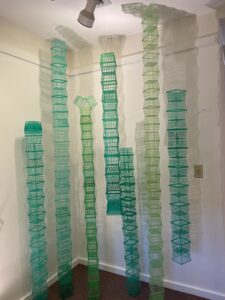
One: I don’t think my work translates very well in two dimensions. It’s really hard to photograph. The other is I don’t care. Much. That’s always been the case with all of these things. I just like to please myself — except I want to put [images of work] out there, and you need this [to do that]. That’s a difficult question. As I’m saying this, I’m also thinking that I get a lot of [electronic] newsletters about art, and I’m fascinated by what people are doing. I find it really motivating to see what this woman did with a bunch of plastic bags. It feeds me. It makes me feel good to look at that work. And certainly during the pandemic when we couldn’t go anywhere. It was necessary. Now, when I’m living in the woods, it’s really handy. I can’t live without it. And, I’m sad it is abused, that the great, democratic bringer-together that the internet was supposed to be has become, in many ways, really horrible.
What do you believe is the visual artist’s role in the world?
The more beauty that can be shared between people, the better. Even if it’s not beautiful, then the more expression of experience, and perceptions of what’s happening all around us, the more we can get that out there in ways that can resonate with lots of different people, I feel that’s the whole point. I used to think that plays could change the world. And, then I thought not-so-much anymore; but it’s important to have them. People have things to say. It shouldn’t be so expensive to go to plays. It shouldn’t be so hard to have any art near you, or part of you. And, that, I think is the most important thing.
How does living in Northern Michigan inform and influence your creative practice?
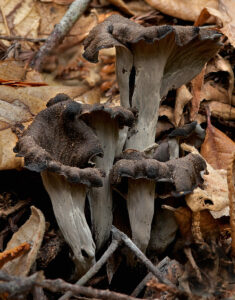
First and foremost, I’m just happier. I wake up. I see critters. I have Black Trumpet mushrooms growing in my yard. I found living in cities to be more than I could handle anymore. So aggressive. So on top of each other. In my old age I’ve become uncomfortable in crowds, and I was always, very much the urban person. I just wanted to be somewhere where what was around me was feeding me more. There’s something about the way the water meets the land here that just grabs my heart. I knew, if I came here, that would be fed, and that would be good. During the eight years in St. Paul I tried to find creative community, but it is very silo’d. The museums are fantastic. But if you’re a bougie, old lady living in St. Paul trying to connect with the young people living in North Minneapolis, that’s really challenging. I had a sense here there was really a strong creative community hiding here, and I would find it. And, I have. I happened to move to a place where there’s six, really great artists within screaming distance.
Who has had the greatest and most lasting influence on your work and practice?
My parents. My family as a whole. I grew up in such an artistic world. I was given art as birthday gifts. I was taken to the ballet because it was cheaper than getting a babysitter. And I was taken to plays, and exposed to things that I don’t think people, particularly now, get. I was given free rein to try stuff. My mother didn’t want me to become an artist or an actor or a dancer because you couldn’t support yourself, but I always have — with another job. So, there’s that: the little world I grew up in. The artists I’ve love and have impacted me are Joseph Cornell, Louise Bourgeois. There’s an artist in Chicago — Mary Ellen Croteau — who was taking plastic tops and creating these wonderful columns with them. I would see her doing stuff I was doing.
Where or to whom do you go when you need honest feedback about your work?
That’s been harder since I left Chicago. When I was at Images Gallery, we had a cooperative that met twice a month, and there were eight to 10 people as any time who were happy to tell you what sucked, and what was working, and what you might think about. That was a gift. Now, I’ve gotten to be friends with a couple of artists, here, who have been helpful about how to think about things. My husband. I’ll pretty much ask anybody who’ll look at the work.
What is the role of the exhibiting in your practice?
Ego. I have something to say. I’ve always had something to say, and put it out however I’m working [e.g. dance, theater, et cetera]. That’s one thing. I think it’s also about finding community. I’ve always looked for calls-for-artists that resonate with something I’m doing, whether it’s recycled art, thematic things.
You’re not looking to exhibit anywhere. You’re making specific choices about the exhibition themes so you can find a fit with the work you’re making.
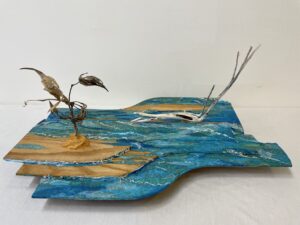
And have made. Having moved here and trying to get the lay of the land … There’s the beach art, which is all kinds of interesting stuff because this place is so beautiful, and everyone wants to paint it. There’s definitely a whole coterie of people doing really edgy, interesting pieces. But I’ve got the sense, particularly because most of it’s sculpture, my work doesn’t go into galleries per se, unless it’s a show of my work. What I realize now, I need to do two things. I want to create some small works that’s accessible so I can get into a gallery. And then, these bigger pieces, which are conceptual, I feel like I need to write a proposal to some of the larger exhibition spaces, and see how that would fit into the work of other people exhibiting work on the wall.
Is exhibiting about putting your work out there so you can get your ideas out there?
Yes. And see what happens with it. But what I’ve learned every time I’ve put something out there, the whole world sees things differently. I can learn from that. I can get hurt by that. I get excited by that. All sorts of things happen. That’s the theater of it, I guess.
How do you feed and nurture your creativity?

I walk. I look. When I’m walking, I can stop. I can take in the whole great, giant thing around me; or I can notice that the little knot in the tree over there looks like an eyeball, and what if I did something with that? I can go from the macro to the micro. Things delight my eyes. I get excited about little things. When I’m doing that, I’m not thinking what’s for dinner, how my son’s doing, the world coming to an end. It’s a break from the good and the bad of everyday existence. I also do tai chi. It clears me out, and then I can look at things different. The other things I’ve added to that is I photograph work in process, then look at it in a photograph, which helps me see things I don’t see. I like to feed my sense. That helps keep things at a place where I can work. When life starts getting really difficult, it gets harder to do that.
What drives your impulse to make?
I don’t know. It’s just there. I’ve always needed, from the time I was a very small person, to be able to create some thing, whether it’s a dance, music, I always needed to do that as part of my life. In my adult life, I’ve been able to do that more than anything else. I’ve been pretty lucky in that respect. It’s part of my DNA. It’s like a sensation. It’s under my skin, and I can’t do anything about it. When I don’t do it, it’s not good. I get stuck. One of the things is that it connects me with people. I like my privacy. I like being quiet. The making lets me be alone, and then, what’s made connects me with people.
Learn more about Carrie Betlyn-Eder here.
Sarah Bearup-Neal develops and curates Glen Arbor Arts Center exhibitions. She maintains a studio practice focused on fiber and collage.
